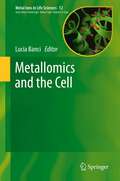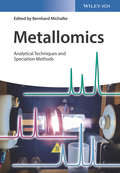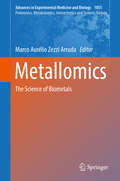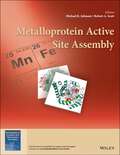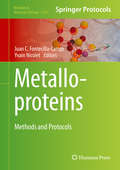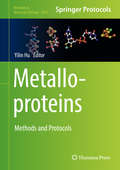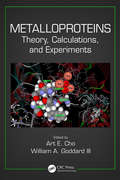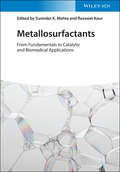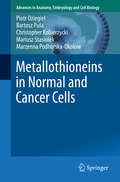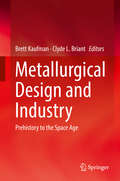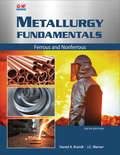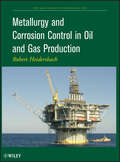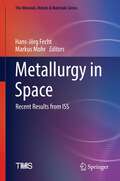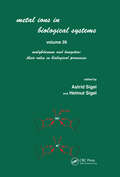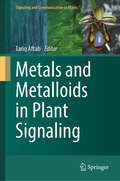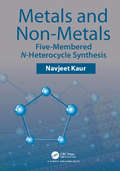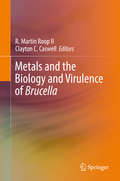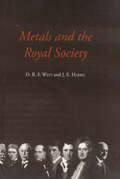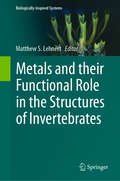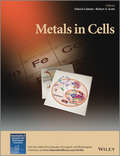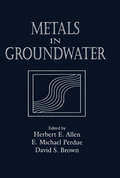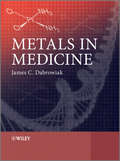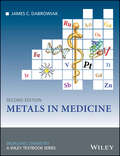- Table View
- List View
Metallomics and the Cell
by Lucia BanciMetallomics and the Cell provides in an authoritative and timely manner in 16 stimulating chapters, written by 37 internationally recognized experts from 9 nations, and supported by more than 3000 references, several tables, and 110 illustrations, mostly in color, a most up-to-date view of the "metallomes" which, as defined in the "omics" world, describe the entire set of biomolecules that interact with or are affected by each metal ion. The most relevant tools for visualizing metal ions in the cell and the most suitable bioinformatic tools for browsing genomes to identify metal-binding proteins are also presented. Thus, MILS-12 is of relevance for structural and systems biology, inorganic biological chemistry, genetics, medicine, diagnostics, as well as teaching, etc.
Metallomics: Analytical Techniques and Speciation Methods
by Bernhard MichalkeLatest developments, new insights and knowledge derived from speciation analysis in one unique compilation: The reader gets acquainted with relevant instrumental as well as application aspects of metallomics approaches, paving the road to understanding fate, pathway, and action of metals in environment and organisms. Upon an introductory chapter on analytical methods and strategies, the full bandwidth of applications is discussed. Expert chapter authors cast spotlights on recent topics such as metallomics applications to environmental and nutrition studies as well as biology and medicine. Special chapters deal with the impact of manganese and iron on neurodegeneration, and the impact of nanoparticles on health.
Metallomics: The Science of Biometals (Advances in Experimental Medicine and Biology #1055)
by Marco Aurélio ArrudaThis book covers the new Omics area, Metallomics. As Metallomics is intrinsically a transdisciplinary area, this book is authored by experts in the field on such diverse topics as Environmental, Nuclear, and Human Metallomics. Within these topics metals play important role, as being part of biomolecules, controlling different biochemical process, being signaling agents, being catalyst of biochemical reactions, among others. This volume demonstrates the importance of more investigation about metals and their interactions with biomolecules. As the knowledge in this field is growing and growing daily, then new challenges concerning studies involving Metallomics is appearing, such as comparative metallomics, speciation metallomics, real-time metallomics, new predictions of metals in biomolecules, metalloprotein databank expansion, interactions between metalloprotein-metalloprotein, among others.
Metalloprotein Active Site Assembly
by Robert A. Scott Michael K. JohnsonSummarizes the essential biosynthetic pathways for assembly of metal cofactor sites in functional metalloproteins Metalloprotein Active Site Assembly focuses on the processes that have evolved to orchestrate the assembly of metal cofactor sites in functional metalloproteins. It goes beyond the simple incorporation of single metal ions in a protein framework, and includes metal cluster assembly, metal-cofactor biosynthesis and insertion, and metal-based post-translational modifications of the protein environments that are necessary for function. Several examples of each of these areas have now been identified and studied; the current volume provides the current state-of-the-art understanding of the processes involved. An excellent companion to the earlier book in this series Metals in Cells—which discussed both the positive and negative effects of cellular interactions with metals—this comprehensive book provides a diverse sampling of what is known about metalloprotein active site assembly processes. It covers all major biological transition metal components (Mn, Fe, Co, Ni, Mo), as well as the other inorganic components, metal-binding organic cofactors (e.g., heme, siroheme, cobalamin, molybdopterin), and post-translationally modified metal binding sites that make up the patchwork of evolved biological catalytic sites. The book compares and contrasts the biosynthetic assembly of active sites involving all biological metals. This has never been done before since it is a relatively new, fast-developing area of research. Metalloprotein Active Site Assembly is an ideal text for practitioners of inorganic biochemistry who are studying the biosynthetic pathways and gene clusters involved in active site assembly, and for inorganic chemists who want to apply the concepts learned to potential synthetic pathways to active site mimics.
Metalloproteins
by Juan C. Fontecilla-Camps Yvain NicoletMetalloproteins are involved in many key biological processes such as gas transport and metabolism, photosynthesis, cell respiration, the Krebs cycle and many other vital redox reactions. "Metalloproteins: Methods and Protocols" addresses multiple aspects of metalloenzyme research from the production and purification of metalloproteins using both standard recombinant techniques and a cell-free system, to the electrochemical analysis of metalloproteins, as well as IR techniques, Mossbauer spectroscopy and the theoretical interpretation of metalloenzyme catalytic and redox processes, to name a few topics. Written in the successful "Methods in Molecular Biology" series format, chapters include introductions to their respective topics, lists of the necessary materials and reagents, step-by-step, readily reproducible protocols and notes on troubleshooting and avoiding known pitfalls. Authoritative and easily accessible, "Metalloproteins: Methods and Protocols" seeks to serve both professionals and novices interested in the metalloprotein field. "
Metalloproteins: Methods and Protocols (Methods in Molecular Biology #1876)
by Yilin HuThis volume provides an up-to-date, in-depth overview of the methods that have been applied to studying the complex metalloproteins at a molecular level. Chapters cover a wide range of approaches focusing on genetic, biochemical, spectroscopic, chemical methods, and theoretical calculations. Written in the highly successful Methods in Molecular Biology series format, chapters include introductions to their respective topics, lists of the necessary materials and reagents, step-by-step, readily reproducible laboratory protocols, and tips on troubleshooting and avoiding known pitfalls. Authoritative and cutting-edge, Metalloproteins: Methods and Protocols aims to be useful for anyone who is interested in metalloprotein research and wants to address the unanswered mechanistic and biosynthetic questions of these fascinating enzyme systems.
Metalloproteins: Theory, Calculations, and Experiments
by Art E. Cho William A. Goddard IIINumerous essential biological functions involve metalloproteins; therefore, understanding metalloproteins and how to manipulate them is significant in the biological and medical fields. An examination of current research, Metalloproteins: Theory, Calculations, and Experiments explores the interplay between theory and experiment, detailing the role
Metallosurfactants: From Fundamentals to Catalytic and Biomedical Applications
by Ravneet Kaur Surinder K MehtaMetallosurfactants Provides up-to-date coverage of the synthesis, properties, and applications of metallosurfactants Metallosurfactants: From Fundamentals to Catalytic and Biomedical Applications is a thorough introduction to amphiphilic compounds that allow to incorporate metal ions in the surfactant system. This comprehensive reference and guide describes the fundamentals of metal surfactant complexes, highlights recent advances in the field, and explores current and future applications and research areas. Gradually progressing from basic to advanced topics, the authors first explain the classification and characterization of metallosurfactants before delving into more complex concepts and various catalytic, sensing, and biomedical applications. The book begins with coverage of the synthesis of metallosurfactants and their surface, interfacial, and aggregation behavior. Subsequent chapters discuss applications of metallosurfactants in areas such as drug delivery, molecular machines, transfection, nanoparticle synthesis, and carbon monoxide-releasing molecules (CORMs). Other topics include the use of metallosurfactants as catalysts in organic reactions, and as anticancer and antimicrobial agents in drug delivery and formulation. This unique reference Provides an overview of the structure-function relationship, synthesis methods, and characterization of metallosurfactants Reviews current trends in metallosurfactant development and research Examines the use of metallosurfactants in a wide range of reactions, including esterolytic reactions and hydrogen generation Discusses advanced applications of metallosurfactants, e.g. as nanoreactors for nanoparticle synthesis, non-viral transfection vectors, and sensors Metallosurfactants: From Fundamentals to Catalytic and Biomedical Applications is an excellent introduction to the growing field of metallosurfactant chemistry as well as a concise, highly useful reference for researchers and scientists in both academia and industry.
Metallothioneins in Normal and Cancer Cells
by Piotr Dziegiel Bartosz Pula Christopher Kobierzycki Mariusz Stasiolek Marzenna Podhorska-OkolowThis book describes the structures of Metallothionein (MT) family members and the cellular functions of MT-1, MT-2 and MT-4 isoforms, as well as provides insights into divergent biological roles of MT-3. The authors explain the involvement of MT molecules in various processes related to carcinogenesis, including an organ-specific presentation of current data concerning their potential impact on the progression of various tumors and the regulatory role of MT family members in the function of the immune system.
Metallurgical Design and Industry: Prehistory to the Space Age
by Brett Kaufman Clyde L. BriantThis edited volume examines metallurgical technologies and their place in society throughout the centuries. The authors discuss metal alloys and the use of raw mineral resources as well as fabrication of engineered alloys for a variety of applications. The applications covered in depth include financial, mining and smelting, bridges, armor, aircraft, and power generation. The authors detail the multiple levels and scales of impact that metallurgical advances have had and continue to have on society. They include case studies with guidance for future research design and innovation of metallic materials relevant to societal needs.Includes case studies written by industry professionals with guidance for future research design and innovation;Demonstrates metal materials design that reflects relevant societal needs;Covers a broad range of applied materials used in aircraft, armor, bridges, and power generation, among others.
Metallurgy Fundamentals: Ferrous and Nonferrous
by Daniel A. Brandt and J.C. WarnerMetallurgy Fundamentals provides instruction on the basic properties, characteristics, and production of the major metal families. Clear, concise language and numerous illustrations make this an easy-to-understand text for an introductory course in metallurgy. Numerous full-color tables, diagrams, and photographs show both the theoretical and practical aspects of metallurgy.
Metallurgy and Corrosion Control in Oil and Gas Production
by Robert HeidersbachThis book is intended for engineers and related professionals in the oil and gas production industries. It is intended for use by personnel with limited backgrounds in chemistry, metallurgy, and corrosion and will give them a general understanding of how and why corrosion occurs and the practical approaches to how the effects of corrosion can be mitigated. It is also an asset to the entry-level corrosion control professional who may have a theoretical background in metallurgy, chemistry, or a related field, but who needs to understand the practical limitations of large-scale industrial operations associated with oil and gas production. While the may use by technicians and others with limited formal technical training, it will be written on a level intended for use by engineers having had some exposure to college-level chemistry and some familiarity with materials and engineering design.
Metallurgy and Corrosion Control in Oil and Gas Production (Wiley Series in Corrosion #8)
by Robert HeidersbachDetails the proper methods to assess, prevent, and reduce corrosion in the oil industry using today's most advanced technologies This book discusses upstream operations, with an emphasis on production, and pipelines, which are closely tied to upstream operations. It also examines protective coatings, alloy selection, chemical treatments, and cathodic protection—the main means of corrosion control. The strength and hardness levels of metals is also discussed, as this affects the resistance of metals to hydrogen embrittlement, a major concern for high-strength steels and some other alloys. It is intended for use by personnel with limited backgrounds in chemistry, metallurgy, and corrosion and will give them a general understanding of how and why corrosion occurs and the practical approaches to how the effects of corrosion can be mitigated. Metallurgy and Corrosion Control in Oil and Gas Production, Second Edition updates the original chapters while including a new case studies chapter. Beginning with an introduction to oilfield metallurgy and corrosion control, the book provides in-depth coverage of the field with chapters on: chemistry of corrosion; corrosive environments; materials; forms of corrosion; corrosion control; inspection, monitoring, and testing; and oilfield equipment. Covers all aspects of upstream oil and gas production from downhole drilling to pipelines and tanker terminal operations Offers an introduction to corrosion for entry-level corrosion control specialists Contains detailed photographs to illustrate descriptions in the text Metallurgy and Corrosion Control in Oil and Gas Production, Second Edition is an excellent book for engineers and related professionals in the oil and gas production industries. It will also be an asset to the entry-level corrosion control professional who may have a theoretical background in metallurgy, chemistry, or a related field, but who needs to understand the practical limitations of large-scale industrial operations associated with oil and gas production.
Metallurgy in Space: Recent Results from ISS (The Minerals, Metals & Materials Series)
by Hans-Jörg Fecht Markus MohrThis book presents experimental work conducted on the International Space Station (ISS) in order to characterize metals and alloys in the liquid state. The internationally recognized authors present and discuss experiments performed in microgravity that enabled the study of the relevant volume and surface related properties free of the restrictions of a gravity-based environment. The collection serves also as a handbook of space experiments using electromagnetic levitation techniques. A summary of recent results provides an overview of the wealth of space experiment data, which will ignite further research activities and inspire academics and industrial research departments for their continuous development.
Metals Ions in Biological System: Volume 39: Molybdenum and Tungsten: Their Roles in Biological Processes: (Metal Ions in Biological Systems)
by Astrid Sigel Helmut SigelVolume 39: Molybdenum and Tungsten: Their Roles in Biological Processes is devoted soley to the vital research area on molybdenum and tungsten and their role in biology. It offers a comprehensive and timely account of this fascinating topic by 40 distinguished international authorities. Topics include: transport, homeostasis, regulation and binding of molybdate and tungstate to proteins, crystallographic characterization, coordination of complexes, and biosynthesis.
Metals and How to Weld Them (second edition)
by T. B. JeffersonIn addition to the information a student would need in order to learn to be an arc welder, this book has an appendix with metallurgy terms. That and its detailed index make this a useful reference tool for those working in careers where welding is an essential skill. There are many different metals, and there is a science of welding. Not just any metals can be bonded together. Each metal has its own properties and uses. There is also a chapter on precious metals.
Metals and Metalloids in Plant Signaling (Signaling and Communication in Plants)
by Tariq AftabIn many parts of the world, soil and water are slightly to moderately contaminated with metals and metalloids such as Cd, Cu, Zn, Ni, Co, Cr, Pb, Si, B and As. This could be due to long-term use of phosphatic fertilizers, sewage sludge application, dust from smelters, industrial waste and bad watering practices in agricultural lands. Beside natural factors, human activities have contributed to the enormous increase in heavy metal and/or metalloid pollution in the environment. Metal and metalloid stress are major abiotic stress factors that limit crop production and reduce agricultural yield. The primary response of plants is the generation of reactive oxygen species (ROS) upon exposure to high levels of metals/metalloids. They either generate ROS directly through Haber-Weiss reactions or overproduction of ROS and occurrence of oxidative stress in plants could be the indirect consequence of metals/metalloids toxicity. The indirect mechanisms include their interaction with the antioxidant system, disrupting the electron transport chain or disturbing the metabolism of essential elements. One of the most deleterious effects induced by heavy metals exposure in plants is lipid peroxidation, which can directly cause biomembrane deterioration. The impact of metals/metalloids on plant water relations has to be distinguished from their effects on water availability in soils, on root growth, limiting water uptake, as well as other phytotoxic effects. If soils are high in soluble salts (including heavy metal salts), the osmotic potential in the soil solution might be lower than the potential of the cell sap in root. Under these circumstances, the soil solution would severely restrict the rate of water uptake by plants and lead to osmotic stress. Further, the negative influence metals/metalloids have on the growth and activities of soil microorganisms, may also indirectly affect the growth of plants. In the book “Metals and Metalloids in Plant Signaling”, we elucidated the effects of metals/metalloids on signaling and communication cascades in plants. The general aim of the present book is to provide a comprehensive analysis of the current situation and development in the field and to develop a science-based theoretical foundation for the conceptualization, and practical application. The various chapters are based on the consideration of metals/metalloids in terms of their action on different regulatory and functional systems of plants (signaling, metabolism, uptake, and transport mechanisms, etc.).
Metals and Non-metals: Five-membered N-heterocycle Synthesis
by Navjeet KaurDesign of new processes that avoid the use of toxic reagents has been the focus of intense research of late. Catalysis by metals and non-metals offers diverse opportunities for the development of new organic reactions with promising range of selectivities—chemoselectivity, regioselectivity, diastereoselectivity, and enantioselectivity. Furthermore, these transformations frequently occur under mild conditions, tolerate a broad array of functional groups, and proceed with high stereoselectivity. The area of catalysis is sometimes referred to as a ‘foundational pillar’ of green chemistry. Catalytic reactions often reduce energy requirements and decrease separations because of increased selectivity; they are also capable of permitting the use of renewable feedstocks of less toxic reagents or minimizing the quantities of reagents needed. New catalytic organic synthesis methodologies have, thus, offered several possibilities for considerable improvement in the eco-compatibility of fine chemical production. Hence, these catalytic methodologies have emerged as powerful tools for the efficient and chemoselective synthesis of heterocyclic molecules. Key Features: Presents the synthesis of different five-membered heterocycles. Contains the most up-to-date information in this fast-moving field. Covers novel catalytic approaches used in the study and application of catalysts in synthetic organic reactions. Presents new methodologies for the synthesis of heterocycles.
Metals and the Biology and Virulence of Brucella
by R. Martin Roop II Clayton C. CaswellThis book summarises the current knowledge on the role played by biologically relevant transition metals (Fe, Mn, Zn, Ni, Co, Cu and Mg) in the basic biology and virulence of bacterial pathogens from the genus Brucella. The authors explore the biological functions of these metals, how these bacteria compete with their mammalian hosts for these metals and how they avoid metal toxicity. Researchers and professionals studying zoonotic pathogens from the genus Brucella find this book valuable.
Metals and the Royal Society
by D. R. WestIn this book two distinguished metallurgists have traced the role of metallurgical technology in the creation of the scientific revolution and the formation of the Royal Society.
Metals and their Functional Role in the Structures of Invertebrates (Biologically-Inspired Systems #18)
by Matthew S. LehnertThis book showcases the diverse strategies used by invertebrate organisms to enhance their structures with metals. Written by the leading scientists in this multidisciplinary field, this book explores a range of metal-enhanced structures that span the world of invertebrates, their wonderous uses, and their applications to human-engineered products. The articles, accompanied by artistic imagery, reveal how metals augment the cuticle of insect mouthparts, the tongue of snails, the slime of slugs, and the claws of crabs. Intended for evolutionary biologists, material scientists, and anybody with an interest in invertebrate biology, this book covers what we currently understand about the adaptive value of metals in structures and lays a foundation for future studies.
Metals in Cells
by Valeria CulottaOver the last three decades a lot of research on the role of metals in biochemistry and medicine has been done. As a result many structures of biomolecules with metals have been characterized and medicinal chemistry studied the effects of metal containing drugs.This new book (from the EIBC Book Series) covers recent advances made by top researchers in the field of metals in cells [the "metallome"] and include: regulated metal ion uptake and trafficking, sensing of metals within cells and across tissues, and identification of the vast cellular factors designed to orchestrate assembly of metal cofactor sites while minimizing toxic side reactions of metals. In addition, it features aspects of metals in disease, including the role of metals in neuro-degeneration, liver disease, and inflammation, as a way to highlight the detrimental effects of mishandling of metal trafficking and response to "foreign" metals. With the breadth of our recently acquired understanding of metals in cells, a book that features key aspects of cellular handling of inorganic elements is both timely and important. At this point in our understanding, it is worthwhile to step back and take an expansive view of how far our understanding has come, while also highlighting how much we still do not know.The content from this book will publish online, as part of EIBC in December 2013, find out more about the Encyclopedia of Inorganic and Bioinorganic Chemistry, the essential online resource for researchers and students working in all areas of inorganic and bioinorganic chemistry.
Metals in Groundwater
by David S. Brown Herbert E. Allen E. Michael PerdueMetal contamination of groundwater results from many human activities, including agriculture, mining, and the disposal of municipal waste and fly ash. Metals in Groundwater describes the transport of metals to groundwater from these and other sources. It also covers risk assessment of metals in groundwater, coupling of chemicals and hydrological models, and sorption of metals onto soils and clays. The speciation of metals is examined in detail. The book will interest researchers in environmental quality, mining, and agriculture; consultants; industry professionals; and personnel within regulatory agencies.
Metals in Medicine
by James C. DabrowiakMetals in Medicine is a textbook directed a senior undergraduates and beginning graduate students, which describes metal-based agents for treating and diagnosing disease. Opening chapters present basic bonding concepts that are applicable to metallo-drugs and their biological targets, interactions that exist between the agents and substances in the biological milieu, basic pharmacokinetic and pharmacodynamic properties including transport and uptake of drugs by the cells, and methods for measuring efficacy and toxicity of agents. The steps from drug discovery to market place are also briefly outlined and discussed. These chapters lay the groundwork, in order that students can clearly understand how agents work, whatever their subject background.The remaining chapters focus on individual metallo-drugs and agents for treating and detecting disease, their synthesis, structure and general properties, known mechanism of action and important physical and chemical principles that apply. Throughout the book, "Feature Boxes" expand on features of drugs that are not directly related to studying metals in medicine, for example discovery, medical use, specialist assays, and metals in biology. At the end of the chapters there are specifically designed problems/exercises that apply basic kinetic, thermodynamic and chemical principles to practical problem solving in metals in medicine.
Metals in Medicine
by James C. DabrowiakWorking from basic chemical principles, Metals in Medicine 2nd Edition describes a wide range of metal-based agents for treating and diagnosing disease. Thoroughly revised and restructured to reflect significant research activity and advances, this new edition contains extensive updates and new pedagogical features while retaining the popular feature boxes and end-of-chapter problems of the first edition. Topics include: Metallo-Drugs and their action Platinum drugs for treating cancer Anticancer agents beyond cisplatin including ruthenium, gold, titanium and gallium Responsive Metal Complexes Treating arthritis and diabetes with metal complexes Metal complexes for killing bacteria, parasites and viruses Metal ion imbalance and its links to diseases including Alzheimer’s, Wilson’s and Menkes disease Metal complexes for detecting disease Nanotechnology in medicine Now in full colour, Metals in Medicine 2nd Edition employs real-life applications and chapter-end summaries alongside feature boxes and problems. It provides a complete and methodical examination of the use of metal complexes in medicine for advanced undergraduate and postgraduate students in medicinal inorganic chemistry, bioinorganic chemistry, biochemistry, pharmacology, biophysics, biology and bioengineering. It is also an invaluable resource for academic researchers and industrial scientists in inorganic chemistry, medicinal chemistry and drug development.
